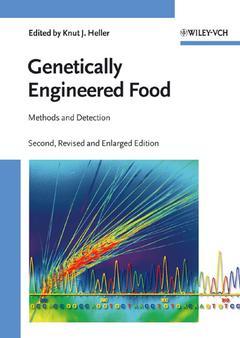Genetically engineered food: Methods & detection (2nd Ed.)
Langue : Anglais
Auteur : HELLER Knut J

Continuing the very successful first edition, this book reviews the most recent changes to the legal situation in Europe concerning genetically engineered food and labeling. Due to the extremely rapid developments in green biotechnology, all the chapters have been substantially revised and updated. examines methods of detection, such as DNA-based methods, and methods for detecting genetic engineering in composed and processed foods.
Part I Application and Perspectives. 1 Transgenic Modification of Production Traits in Farm Animals (Gottfried Brem and Mathias Müller). 1.1 Introduction. 1.2 The Creation of Transgenic Animals. 1.3 Gene Transfer in Poultry. 1.4 Gene Transfer in Fish. 1.5 Transgenes - Gene Constructs. 1.6 Transgenic Animals with Agricultural Traits. 1.7 Improved Growth Rate, Carcass Composition, and Feed Efficiency. 1.8 Alteration of the Composition of Milk. 1.9 Improved Animal Health. 1.10 Improved Biochemical Pathways. 1.11 Improved Wool Production. 1.12 Transgenic Farm Animals, Biosafety Issues, Animal Welfare, and Ethics. 1.13 Conclusion. References. 2 Genetically Modified Plants (Susanne Stirn and Horst Lörz). 2.1 Methods for Establishing Genetically Modified Plants. 2.2 GM Plants Already on the Market (EU, USA, Canada, Japan). 2.3 GM Plants "In the Pipeline". 2.4 Outlook. References. 3 Fermentation of Food by Means of Genetically Modified Yeast and Filamentous Fungi (Rena Leisegang, Elke Nevoigt, Anja Spielvogel, Georg Kristan, Anke Niederhaus and Ulf Stahl). 3.1 Introduction. 3.2 Yeast. 3.3 Filamentous Fungi. 3.4 Prospects. Acknowledgements. References. 4 Production of Food Additives Using Filamentous Fungi (Carsten M. Hjort). 4.1 Filamentous Fungi in Food Production. 4.2 Additives for the Food Industry. 4.3 Design of Genetically Modified Microorganisms for Production of Food Additives and Processing Aids. 4.4 Industrial Enzyme Production Processes. References. 5 Genetic Engineering of Bacteria Used in Food Fermentation (Arnold Geis). 5.1 Introduction. 5.2 Lactic Acid Bacteria. 5.3 Perspectives and Objectives. 5.4 Methods. 5.5 Conclusions. References. Part II Legislation in Europe. 6 The Legal Situation for Genetically Engineered Food in Europe (Rudolf Steinz and Jan Kalbheim). 6.1 Introduction. 6.2 The Law Applicable to Genetically Modified Food. References. Part III Methods of Detection. 7 Detection of Genetic Modifications - Some Basic Considerations (Knut J. Heller). 7.1 The Conversion of Genetic Information from DNA to Phenotypes. 7.2 DNA, Protein, and Phenotypes as Targets for Detection Assays. 7.3 Food-grade Modifications. 7.4 Detection of Unknown Modifications. 8 DNA-based Methods for Detection of Genetic Modifications (Ralf Einspanier). 8.1 Introduction. 8.2 Recent DNA Methodology. 8.3 Specific Detection of Genetic Material. 8.4 Nucleic Acid Amplification Methods using PCR. 8.5 Alternative and Promising DNA Detection Techniques. 8.6 Conclusions and Future Prospects for GMO Detection by DNA Analysis. References. 9 Genetic Engineering of Fish, and Methods of Detection (Hartmut Rehbein). 9.1 Introduction. 9.2 Development and Production of Transgenic Fish. 9.3 Examples of Successful Production of Transgenic Fish. 9.4 Methods of Detecting Processed Transgenic Fish. 9.5 Food Safety of Transgenic Fish. References. 10 Detection Methods for Genetically Modified Crops (Rolf Meyer). 10.1 Introduction. 10.2 Isolation of plant DNA. 10.3 Detection Strategies. 10.4 Outlook, Conclusions. References. 11 Methods for Detection of Genetically Modified Organisms in Composite and Processed Foods (Karl-Heinz Engel, Francisco Moreano, and Alexandra Ehlert). 11.1 Introduction. 11.2 Challenges Specific to the Detection of GMO in Composite and Processed Foods. 11.3 Degradation of Proteins and DNA. 11.4 Analytical Methods. 11.5 Conclusions. References. 12 Mutations in Lactococcus lactis and their Detection (Jan Kok and Bertus van den Burg). Summary. 12.1 Introduction. 12.2 The Composition of the Genome of Lactococcus lactis. 12.3 Flexibility in the Genome of Lactococcus lactis. 12.4 Conjugation. 12.5 Transduction. 12.6 Transformation. 12.7 IS Elements and Transposons. 12.8 Lactococcal Phages as Sources of Genetic Plasticity. 12.9 An Example of Natural Genetic Flexibility: The L. lactis NCDO712 Family. 12.10 Mutations in Lactococcus lactis as a Consequence of Environmental Factors and DNA Metabolism. 12.11 Methods of Mutating the Genome of L. lactis. 12.12 Genetic Engineering of Lactococcus lactis. 12.13 Strategies for Detection of Genetically Modifi
Date de parution : 10-2006
Ouvrage de 322 p.
Thèmes de Genetically engineered food: Methods & detection :
© 2024 LAVOISIER S.A.S.


